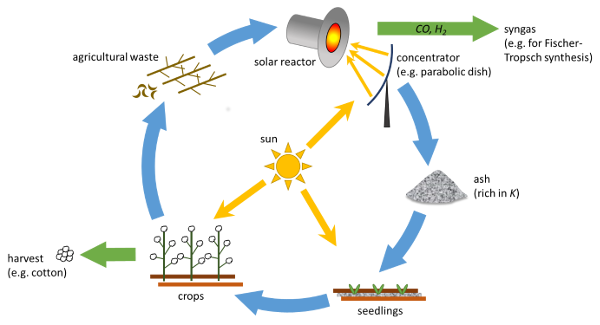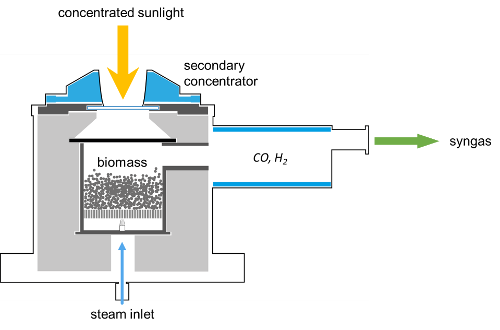SNF-Project Solar thermochemical gasification of agricultural waste
Funding source: external page Schweizerischer Nationalfonds zur Förderung der wissenschaftlichen Forschung (SNF)
Partners: external page Council of Scientific & Industrial Research – Central Salt & Marine Chemicals Research Institute (CSIR-CSMCRI), India
Background – In developing countries, a large fraction of crop residues is disposed of by simply burning them in situ, mainly for clearing the fields for the subsequent cultivation cycle. In the specific case of India, these crops include rice, wheat, cotton, maize, millet, sugar cane, jute, rapeseed-mustard, and groundnut. Apart from the loss of potentially useful energy, such direct incineration under uncontrolled conditions leads to release of soot particles and other pollutants, as well as to adverse impacts on soil properties. New technologies providing incentives for the collection and productive utilization of those waste materials (150Mt per year), without depriving the soils of essential nutrients, are required.
As an energy-efficient and CO2-neutral way for energy production from waste biomass, solar thermal gasification into energy-rich and high-quality syngas (synthesis gas – a mixture of CO and H2) is proposed. Syngas can be used as a combustion fuel, e.g. for cement kilns or in IGCC-plants for power generation, or further processed to H2 or liquid hydrocarbon fuels. The advantages of the solar-driven process compared to the conventional one are 4-fold:
- Higher syngas output per unit of feedstock.
- Avoidance of syngas contamination by combustion of by-products.
- Higher quality of the produced syngas thanks to higher gasification temperatures.
- Elimination of the upstream air-separation unit.
Ultimately, solar gasification offers an efficient means of storing intermittent solar energy in a transportable and dispatchable chemical form. Gujarat, the region where the Indian partner CSIR-CSMRCI is located, offers among the highest solar resource in the country, comparable to that of traditional solar energy exploitation regions such as southern Spain or the south-West of the US.

Efficient gasification of a carbonaceous feedstock is achieved at high temperatures, preferably above 1000 °C. To reach such temperatures, concentrating optics deliver highly concentrated solar radiative flux to the aperture of the cavity-type gasification reactor. The net reaction is given by:
$$ \mathrm{C+H_2O} \rightarrow \mathrm{CO+H_2}, \Delta H_{298K}^{°}=131\frac{kJ}{mol}$$
A packed-bed solar reactor is proposed (see Figure 2). Packed bed reactors are relatively simple and accommodate a wide range of feedstock sizes and shapes. Steam is injected through a nozzle at the bottom of the reactor.

Objectives – The project aims at the engineering development of a 5 kW solar reactor prototype for gasification of crop residues. The reactor development work involves:
- design
- fabrication
- testing
- modeling and validation
- optimization
- characterization of feedstock, ash and syngas composition
Project-related Publications